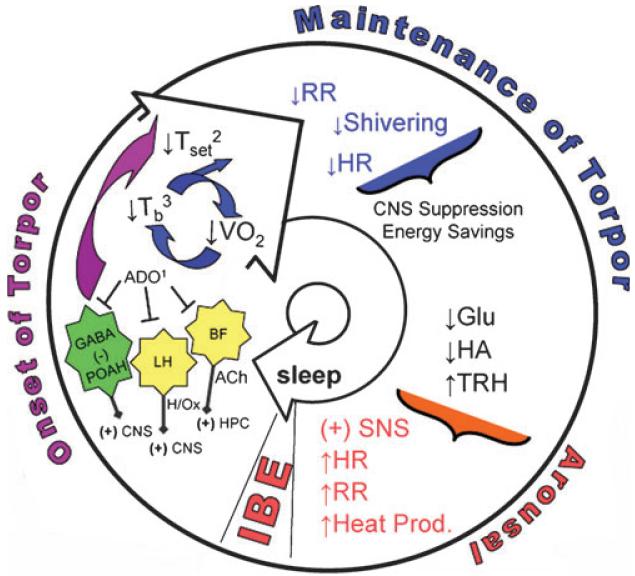Fig. 2.
Hypothesized mechanisms regulating onset, maintenance and arousal from an individual torpor bout. This process repeats itself in a regular manner throughout the hibernation season as shown in Fig. 1. Adenosine (1) is hypothesized to initiate the onset of torpor through sleep promoting mechanisms and through a decrease in Tset within the POAH. The decrease in Tset (2) results in an immediate decrease in metabolism via decreased heat production. HR and RR then decrease due to activation of PSNS and decreased energy demand. Direct influence on ANS may also contribute to metabolic suppression. Subsequent cooling (3) decreases neuronal activity. Cooling-induced decrease in activity of medial septohippocampal neurons decreases theta rhythm until EEG becomes isoelectric. Cooling also produces additional metabolic suppression through temperature-dependant (Q10) reductions in metabolic processes. Torpor is maintained via temperature dependent suppression of biochemical processes, -Opioid receptor activation and possibly via melatonin-mediated inhibition of respiration, and glu stimulation of PSNS or glu and HA stimulation of inhibitory pathways influencing arousal. Arousal is hypothesized to result from depletion of a signaling molecule, such as Glu or HA and activation of the SNS via TRH. ADO (adenosine); BF (basal forebrain); LH (lateral hypothalamus); POAH (preoptic anterior hypothalamus); ACh (acetylcholine); HPC (hippocampus); H/Ox (hypocretin/Orexin); Tset (threshold temperature of hypothalamus necessary to induce thermogenesis); PSNS (parasympathetic nervous system), ANS (autonomic nervous system); VO2 (whole animal oxygen consumption); HR (heart rate); RR (respiratory rate); Tb (core body temperature); Q10 (ratio of reaction rates for a 10°C change in tissue temperature); SCN (suprachiasmatic nucleus); Glu (glutamate); HA (histamine); TRH (thyrotropin-releasing hormone); SNS (sympathetic nervous system); IBE (interbout euthermy).

